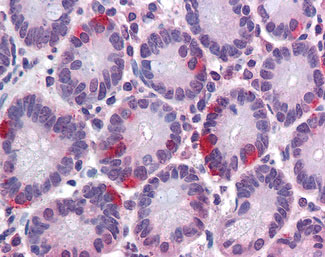SAR1A / SAR1 Antibody (Internal)
Goat Polyclonal Antibody
- SPECIFICATION
- CITATIONS
- PROTOCOLS
- BACKGROUND

Application
| WB, IHC-P, E |
|---|---|
| Primary Accession | Q9NR31 |
| Reactivity | Human |
| Host | Goat |
| Clonality | Polyclonal |
| Calculated MW | 22kDa |
| Dilution | ELISA (1:32000), IHC-P (3.75 µg/ml), WB (0.1-0.3 µg/ml) |
| Gene ID | 56681 |
|---|---|
| Other Names | GTP-binding protein SAR1a, COPII-associated small GTPase, SAR1A, SAR1, SARA, SARA1 |
| Target/Specificity | Human SAR1A. |
| Reconstitution & Storage | Store at -20°C. Minimize freezing and thawing. |
| Precautions | SAR1A / SAR1 Antibody (Internal) is for research use only and not for use in diagnostic or therapeutic procedures. |
| Name | SAR1A (HGNC:10534) |
|---|---|
| Synonyms | SAR1, SARA, SARA1 |
| Function | Small GTPase that cycles between an active GTP-bound and an inactive GDP-bound state and mainly functions in vesicle-mediated endoplasmic reticulum (ER) to Golgi transport. The active GTP-bound form inserts into the endoplasmic reticulum membrane where it recruits the remainder of the coat protein complex II/COPII. The coat protein complex II assembling and polymerizing on endoplasmic reticulum membrane is responsible for both the sorting of cargos and the deformation and budding of membranes into vesicles destined to the Golgi (PubMed:23433038, PubMed:32358066, PubMed:36369712). The GTPase activity of SAR1 by controlling the timing of COPII budding regulates the size of the formed vesicles and is important for cargo selection depending on their size (PubMed:32358066). Together with SEC16A, forms the organized scaffold defining endoplasmic reticulum exit sites (ERES), some specific domains of the endoplasmic reticulum where COPII vesicles form (PubMed:17005010). In addition to its role in vesicle trafficking, can also function as a leucine sensor regulating TORC1 signaling and more indirectly cellular metabolism, growth and survival. In absence of leucine, interacts with the GATOR2 complex via MIOS and inhibits TORC1 signaling. The binding of leucine abrogates the interaction with GATOR2 and the inhibition of the TORC1 signaling. This function is completely independent of the GTPase activity of SAR1B (PubMed:34290409). |
| Cellular Location | Endoplasmic reticulum membrane; Peripheral membrane protein. Golgi apparatus, Golgi stack membrane; Peripheral membrane protein. Cytoplasm, cytosol. Lysosome membrane. Note=Active at endoplasmic reticulum exit sites (ERES) where it inserts into the membrane and recruits the remainder of the coat protein complex II/COPII (PubMed:23433038, PubMed:32358066). Upon leucine deprivation, associates with lysosomal membranes to repress TORC1 signaling (Probable) |

Thousands of laboratories across the world have published research that depended on the performance of antibodies from Abcepta to advance their research. Check out links to articles that cite our products in major peer-reviewed journals, organized by research category.
info@abcepta.com, and receive a free "I Love Antibodies" mug.
Provided below are standard protocols that you may find useful for product applications.
Background
Involved in transport from the endoplasmic reticulum to the Golgi apparatus (By similarity). Required to maintain SEC16A localization at discrete locations on the ER membrane perhaps by preventing its dissociation. SAR1A-GTP-dependent assembly of SEC16A on the ER membrane forms an organized scaffold defining endoplasmic reticulum exit sites (ERES).
References
South S.T.,et al.J. Cell Biol. 149:1345-1360(2000).
Wiemann S.,et al.Genome Res. 11:422-435(2001).
Pietas A.,et al.Submitted (SEP-2000) to the EMBL/GenBank/DDBJ databases.
Ota T.,et al.Nat. Genet. 36:40-45(2004).
Deloukas P.,et al.Nature 429:375-381(2004).
If you have used an Abcepta product and would like to share how it has performed, please click on the "Submit Review" button and provide the requested information. Our staff will examine and post your review and contact you if needed.
If you have any additional inquiries please email technical services at tech@abcepta.com.













 Foundational characteristics of cancer include proliferation, angiogenesis, migration, evasion of apoptosis, and cellular immortality. Find key markers for these cellular processes and antibodies to detect them.
Foundational characteristics of cancer include proliferation, angiogenesis, migration, evasion of apoptosis, and cellular immortality. Find key markers for these cellular processes and antibodies to detect them. The SUMOplot™ Analysis Program predicts and scores sumoylation sites in your protein. SUMOylation is a post-translational modification involved in various cellular processes, such as nuclear-cytosolic transport, transcriptional regulation, apoptosis, protein stability, response to stress, and progression through the cell cycle.
The SUMOplot™ Analysis Program predicts and scores sumoylation sites in your protein. SUMOylation is a post-translational modification involved in various cellular processes, such as nuclear-cytosolic transport, transcriptional regulation, apoptosis, protein stability, response to stress, and progression through the cell cycle. The Autophagy Receptor Motif Plotter predicts and scores autophagy receptor binding sites in your protein. Identifying proteins connected to this pathway is critical to understanding the role of autophagy in physiological as well as pathological processes such as development, differentiation, neurodegenerative diseases, stress, infection, and cancer.
The Autophagy Receptor Motif Plotter predicts and scores autophagy receptor binding sites in your protein. Identifying proteins connected to this pathway is critical to understanding the role of autophagy in physiological as well as pathological processes such as development, differentiation, neurodegenerative diseases, stress, infection, and cancer.



